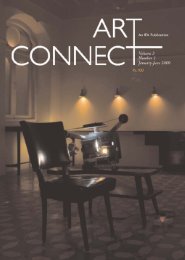Annual report 2003-2004 - India Foundation for the Arts
Annual report 2003-2004 - India Foundation for the Arts
Annual report 2003-2004 - India Foundation for the Arts
- No tags were found...
You also want an ePaper? Increase the reach of your titles
YUMPU automatically turns print PDFs into web optimized ePapers that Google loves.
. . . <strong>the</strong> tightly choreographed scenes, <strong>the</strong> breathless pacing, <strong>the</strong> highpitchedchanting and <strong>the</strong> incredible noise and decibel levels that <strong>the</strong>actors are able to achieve . . . is a <strong>for</strong>m that is clearly best suited to <strong>the</strong>drama of <strong>the</strong> street, where <strong>the</strong>re is no possibility of a captive audienceand where onlookers will necessarily leave if <strong>the</strong> per<strong>for</strong>mance doesn’tgrab <strong>the</strong>ir immediate attention.From Lalit Vachani’s proposal (<strong>2003</strong>) to produce a film on <strong>the</strong> street <strong>the</strong>atre group Jana Natya Manch (Janam).Photographs courtesy Janam.Ano<strong>the</strong>r seed grant had been awarded tovisual artist Vasudha Thozhur to work withactivist/writer Bina Srinivasan to produce artworksthat contribute to a secular response to<strong>the</strong> Gujarat riots. Because of <strong>the</strong> exigencies of‘<strong>the</strong> emergency situation’, however, <strong>the</strong> collaboratorswere continuously being called upon toundertake different chores, each relevant andjustifiable in its context. And while NGOsshowed interest in organising art workshops,<strong>the</strong>y felt constrained to give priority to ‘farmore important’ issues. As a result, <strong>the</strong> collaboratorswere rarely able to accomplish <strong>the</strong>activities as planned and could not arrive at ashared understanding of <strong>the</strong>ir respective rolesand responsibilities in <strong>the</strong> project.Never<strong>the</strong>less <strong>the</strong> grant enabled Vasudha toclarify how as an artist she might relevantlyengage with <strong>the</strong> work of civil society organisations.It also led her to make valuable attemptsto create a visual language that would addresschronic and urgent social concerns. She hasnow sought support to collaborate withHimmat, an NGO working with women survivorsof <strong>the</strong> Gujarat riots. Her plan is to conduct aseries of art workshop with a group of fivewomen, exploring notions of colour, compositionand <strong>for</strong>m, using both conventional mediaand found materials, and also enabling <strong>the</strong>women to produce narrative works that record<strong>the</strong>ir own stories. However, while <strong>the</strong> work sheproposes to undertake with <strong>the</strong> women wouldprovide valuable pointers <strong>for</strong> contemporary artpractice, we felt that it could not properly becalled collaborative in character. IFA is <strong>the</strong>re<strong>for</strong>econsidering <strong>the</strong> possibility of making aspecial grant to support this project.The collaboration between photographerManas Bhattacharya, graphic designer ArjunDutta, and painter Debashis Sarkar to developa body of new digital artwork has been progressingat a frenetic pace. Two new collaboratorshave joined <strong>the</strong> team—Subhadeep Ghosh,a computer engineer turned film editor, andDipayan Sarkar, a self-taught painter. They havealready produced more than 400 images. Therandomness that characterised <strong>the</strong>ir work in<strong>the</strong> early stages still remains a problem, though<strong>the</strong>y claim that <strong>the</strong>ir excitement about <strong>the</strong>possibilities of <strong>the</strong> digital media has abated11










